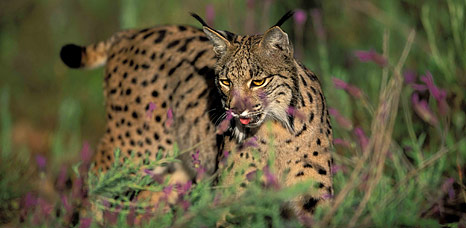Lynx watching is a hot topic at the moment. Tour leader Byron Palacios had a double whammy with a small group on our March 2011 tour, with outstanding views both in Donana and in the Sierra Morena, and with operations manager Paul Stanbury also out of the office earlier this spring on a private Lynx quest during a few days off, Andy Tucker thinks back to September 2006, with memories of Naturetrek's first stab at 'Europe's big cat'.
Iberian Lynx (Herminio Muniz)
Warm Andalusian sunshine greeted us in mid-September 2006 as we landed at Seville to embark on Naturetrek’s inaugural ‘Realm of the Lynx’ holiday. Having led our Coto Donana & Extremadura tour on several previous occasions (even seeing Lynx briefly with our group in 2000), and having paid a short exploratory visit to the Sierra Moreno in July, I knew the lie of the land but nevertheless an extra buzz of adrenaline and the factor of the unknown always seems to accompany a brand new tour. Donana, despite being virtually dry at this time of year (such a different sight to April/May when the marshes adjacent to El Rocio are brim full with water), didn’t disappoint. We had already located Black Stork (two juveniles presumed recently arrived from Extremadura) and Black-shouldered Kite during the first evening, before spending all of day two touring Donana’s rutted tracks through the varied mosaic of habitats in land rovers. Red and Fallow Deer barking across the marismas through the early morning mist was memorable, as was the Spanish Imperial Eagle that we ‘scoped atop a pylon. We saw plenty of evidence of the Lynx conservation programme: from rabbit corrals (the chief food source of the Lynx) to passageways underneath the roads and Lynx-friendly wire fences, if there is such a thing. The ever-tightening noose of roads surrounding the whole Guadalquiver delta probably presents the single greatest threat to this critically endangered feline. Fiercely territorial, as are all wild cats, young Lynx must spread out in search of new territory and it is at this dispersal stage when they are at their most vulnerable, with several killed each year in collisions with traffic. Unless a safe green belt can be forged through the intense agriculture which surrounds the protected area in Donana, enabling young Lynx to establish new territories, the gene pool will remain weak, and the future of Donana’s Lynx, in anything but a highly manipulated and limited manner, looks doomed.
Day 3 and we again set off pre-dawn for the national park. A sighting of a Lynx-like creature emerging from a bush in the early morning gloom set the pulse racing, but the sighting remained unconfirmed. A short while later and we were treated to a Lynx encounter beyond our wildest dreams! An adult female was spotted sitting in the gloom beside the track. She lay down, licked herself and called, presumably to her two cubs, which remained hidden from view. After several minutes, she wandered off into the scrub in an unconcerned fashion, leaving group members elated. Incredibly lucky to encounter a wild Lynx, and to witness completely natural behaviour in the open for several minutes, our joy was only curtailed by the knowledge we now had of what peril these magnificent creatures are in.
Now it was time to head to the hills north of Seville. Biologically isolated from the Donana population for probably 25 years or more, Iberian Lynx in the Sierra Morena number just over 100. These rugged hills provided ideal territory for Lynx in the recent past, but the remaining viable population is hemmed in between huge private hunting estates and an ever-expanding road network. Any notion that spotting a Lynx was easy after our flush of success in Donana was quashed in the Sierra’s huge panoramic vistas. We dedicated many hours at dawn and dusk and although rewarded with Red and Fallow Deer, Spanish Imperial, Golden and Bonelli’s Eagles, Wild Boar and evidence of Lynx (excretia), the cats themselves remained – in the words of our excellent local guides – phantoms of the hills.
The tour was perhaps summed up during our last evening. Dusk was quiet, only the barking of deer and croaking of frogs breaking the monotony of several hours of fruitless scanning. Suddenly, a superb Eagle Owl flew over our heads from the trees behind, and settled majestically on the rocks opposite – a magnificent bird, a true denizen of the ‘Realm of the Lynx’, at one with its environment. We left Andalusia with the hope that these two species – ambassadors for the wild regions that remain in southern Spain – would continue to share this land into and beyond the next generation.
For more information on our 'Spain – Realm of the Iberian Lynx' tour, click here.



 Loading search...
Loading search...
